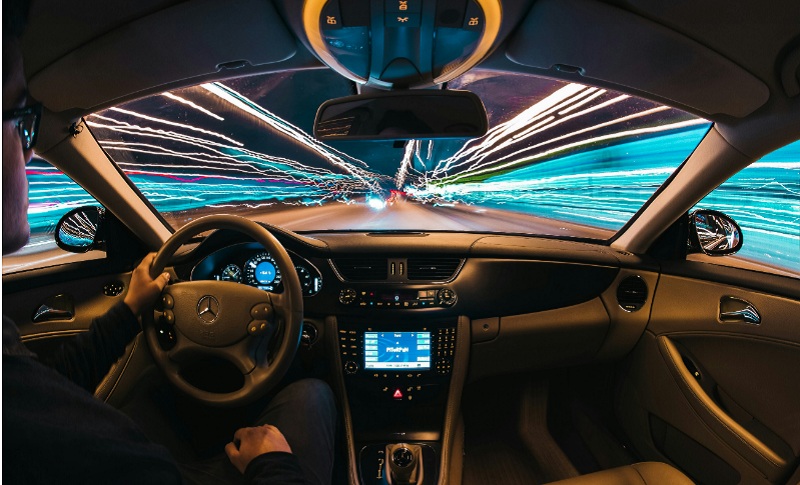By Himani Sikarwar and Karnish Tapadar
A car learning to drive itself by watching online videos? Sounds like science fiction…but in 2024, Tesla CEO Elon Musk confirmed that it had trained its autonomous driving system in China using exactly that approach. Tesla’s AI didn’t simply follow code-based logic. It learned through observation, mirroring how humans learn to drive by watching others navigate both routine and unpredictable moments.
This remarkable method is just one glimpse into a broader revolution underway. Welcome to the Internet of Vehicles (IoV)—a rapidly expanding, intelligent network connecting not only cars to each other, but also to infrastructure, the cloud, and increasingly, to you.
Today’s car is no longer just a collection of mechanical parts. It is a mobile data centre on wheels, packed with sensors, connectivity modules, and real-time analytics. With the arrival of the IoV, vehicles are becoming fully integrated components in a digital ecosystem, engaging in constant dialogue with their surroundings.
This connectivity is typically of three main types:
Vehicle-to-Vehicle (V2V): Cars can exchange data about speed, direction, and hazards. If a vehicle hits the brakes suddenly, nearby cars are notified almost instantaneously.
Vehicle-to-Infrastructure (V2I): Vehicles interact with road infrastructure such as traffic lights, toll booths, and weather sensors enabling dynamic adjustments like traffic signal timing based on real-time traffic flow.
Vehicle-to-Cloud (V2C): Cars continuously upload and retrieve data to and from the cloud, supporting everything from real-time navigation to software patches and diagnostics.
The IoV is already working in real-life situations. Singapore has deployed IoV systems in high-risk areas, resulting in a 30 percent reduction in accidents.
Benefits on the road
One of the clearest benefits of IoV is enhanced safety. Traditional safety systems like blind spot monitors or lane-keeping assists only perceive the immediate environment. IoV takes it a step further: a car can be informed about an accident two kilometres ahead, or a pedestrian stepping onto the road around a blind corner.
This capability doesn’t just make individual vehicles safer. It helps entire fleets act more intelligently. If adopted widely, V2V and V2I technologies could lead to a dramatic reduction in multi-car pileups, especially in low-visibility or high-speed conditions.
Imagine your morning commute without unexpected bottlenecks. IoV-enabled vehicles don’t just react to traffic—they predict and adapt. By communicating with infrastructure and other vehicles, they can optimise routes in real time, redistributing flow before a jam even begins to form.
In pilot programs, such as Audi’s Traffic Light Information system, vehicles communicate with traffic signals to avoid red lights. They also tell drivers how long until a light changes, reducing idling time and improving fuel efficiency.
Another powerful application is predictive maintenance. Instead of waiting for a part to fail, connected cars can detect subtle changes—vibrations, temperature spikes, or fluid inconsistencies—and issue alerts days or even weeks before breakdowns.
This isn’t merely about convenience. For logistics companies and commercial fleets, predictive maintenance can reduce downtime, cut costs, and improve safety. Companies like Tesla and BMW now routinely deploy over-the-air (OTA) software updates, allowing vehicles to receive new features, fix bugs, and even tweak performance without stepping into a garage.
Privacy and hacking risks
As with any powerful technology, the IoV introduces new vulnerabilities that are already raising red flags among privacy advocates and national security experts.
Modern vehicles can log everything from your location history to your driving style and even your in-car conversations. While this data helps improve user experience and safety, it also creates a rich profile of your habits—and raises critical security and privacy concerns.
If your car is connected to the internet, it can be hacked.
In a recent incident, Subaru faced criticism when security researchers found flaws that allowed remote access to vehicle controls including unlocking and starting the car without the owner’s consent, apart from at least a year’s worth of location history.
Perhaps the most chilling example came in 2015, when two cybersecurity researchers remotely accessed a Jeep Cherokee as part of an experiment. They were able to cut its brakes, kill its engine, and manipulate steering—all while the vehicle was in motion on a highway. The demonstration forced Fiat Chrysler to recall 1.4 million vehicles and sparked a wave of legislation aimed at securing automotive software.
Geopolitical concerns are also intensifying. The U.S. government is weighing a potential ban on Chinese-made connected cars, citing espionage risks. Commerce Secretary Gina Raimondo warned that features like embedded microphones, cameras, and real-time GPS tracking could be exploited by foreign governments for spying.
This isn’t paranoia. As cars become more connected, they become moving surveillance devices—capable of recording not just journeys, but also conversations, behaviours, and routines.
The road ahead
Governments around the world are now scrambling to keep up. The European Union has proposed new standards mandating end-to-end encryption for all vehicle data and requiring companies to disclose how that data is stored, used, and shared.
In the US, legislation such as the Auto Data Privacy and Autonomy Act is under review, aiming to create a federal framework for connected car regulation. Still, enforcement remains patchy, and the technology is evolving far faster than the law.
Automakers, meanwhile, are forming their own coalitions to establish best practices for IoV cybersecurity, hoping to stave off heavier regulation by demonstrating self-governance.
The Internet of Vehicles isn’t a futuristic, imaginary scenario. It’s already here, quietly becoming part of our cars and traffic infrastructure.
Tesla’s use of internet videos to train its AI might seem like a one-off novelty, but it reflects a deeper truth: cars are no longer learning from humans—they’re learning from data. They are beginning to think, decide, and even act on our behalf.
The steering wheel may still be in our hands—for now. But as control shifts increasingly to algorithms and sensors, we must ask: Can we trust the machine to steer us safely into the future?
Dr. Himani Sikarwar is an Assistant Professor at the Shiv Nadar Institution of Eminence, Delhi-NCR. Her research focuses on advanced security solutions for the Internet of Vehicles.
Dr. Karnish Tapadar is an Assistant Professor at the Shiv Nadar Institution of Eminence, Delhi-NCR. Her research focuses on computer networks, particularly the Internet of Things.















